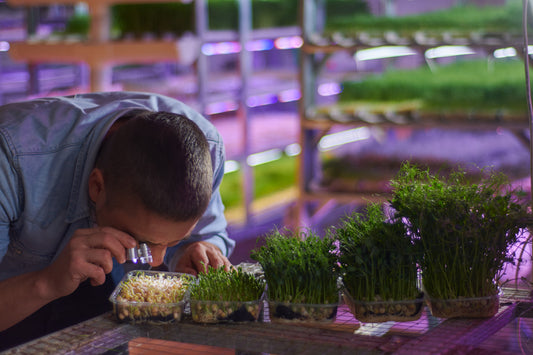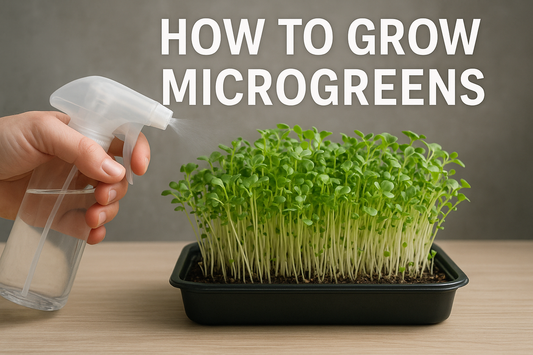
Cress Microgreens: Health Benefits, Growing Guide, and Culinary Uses
Share
Cress Microgreens: Tiny Greens with Mighty Benefits
Hello, green enthusiasts! Ivan from Green Chief here. Today, I'm excited to share everything you need to know about one of my favorite microgreens – garden cress. These tiny powerhouses bring a peppery punch to your plate while delivering impressive health benefits. Let's dive in!
What Are Cress Microgreens?
Garden cress (Lepidium sativum) microgreens are the young seedlings of the cress plant, harvested just days after germination when they're tender, flavorful, and packed with nutrients.
Many people confuse garden cress with watercress (Nasturtium officinale), but they're actually different plants from the same Brassicaceae family. While both offer a peppery flavor, garden cress is easier to grow at home and has a milder, more delicate taste compared to watercress's stronger bite. Watercress typically grows semi-aquatically, while garden cress thrives in soil.

Health Benefits: Small but Mighty
Cress microgreens might be tiny, but they pack a serious nutritional punch:
- Nutrient-dense: Rich in vitamins A, C, E, K, and B-complex
- Mineral powerhouse: Contains calcium, iron, magnesium, and potassium
- Antioxidant properties: Helps combat oxidative stress
- Digestive support: Contains dietary fiber for gut health
According to Dr. Sarah Johnson, nutritionist at the Plant-Based Nutrition Institute, "Cress microgreens contain up to 40 times more nutrients than their mature counterparts. Their high concentration of glucosinolates makes them particularly beneficial for supporting detoxification pathways in the body."
Growing Your Own Cress Microgreens: A Step-by-Step Guide
I love growing cress because it's possibly the easiest and fastest microgreen to cultivate at home. Here's how:
- Gather supplies: You'll need cress seeds, a shallow container, growing medium (paper towels, coconut substrate, fiber mats, or agrowool), and a spray bottle
- Prepare your growing medium: Moisten your chosen medium in your container
- Sprinkle seeds: Distribute seeds evenly across the surface (no need to bury them)
- Create darkness: Cover the container with another tray or cloth for the first 2-3 days to encourage germination. Maintain a temperature between 18-22°C during this blackout period
- Uncover and provide light: After germination, remove the cover and place in indirect light (no direct sunlight!)
- Keep moist: Spray with water 1-2 times daily
- Harvest: After 7-10 days, when they're 2.5-5 cm tall, cut just above the growing medium with scissors
Pro tip: Try growing cress on a windowsill in cute containers – they make lovely living decorations while providing fresh greens!

Fascinating Cress Facts
Did you know cress has been cultivated for over 3,000 years? Ancient Persians consumed cress as early as 400 BCE, believing it sharpened the mind. In fact, Persian king Xerxes had his soldiers eat cress before battle!
Another interesting fact: cress was one of the first plants grown in space! NASA has included it in their space garden experiments due to its rapid growth and nutritional profile.
Cress in the Kitchen
The distinctive peppery flavor of cress microgreens makes them versatile in the kitchen. Chef Miguel Torres, known for his plant-forward cuisine, shares: "Cress microgreens add a beautiful peppery note to dishes without overwhelming them. I particularly love using them as a finishing touch for soups, where their subtle heat cuts through creamy textures."
My favorite ways to enjoy cress:
- Sprinkle on avocado toast for a peppery kick
- Add to sandwiches and wraps
- Blend into smoothies for a nutrient boost
- Use as a garnish for soups and salads
- Mix into soft cheese spreads
Conclusion
Cress microgreens offer a perfect combination of accessibility, nutrition, and flavor. Whether you're a gardening beginner or a seasoned home chef, these peppery little greens deserve a place in your kitchen and diet. They're proof that good things truly come in small packages!
So grab some seeds, set up a simple growing station, and in just a week, you'll be enjoying fresh, home-grown microgreens that brighten up any meal. Happy growing and even happier eating!
Green Chief Ivan











